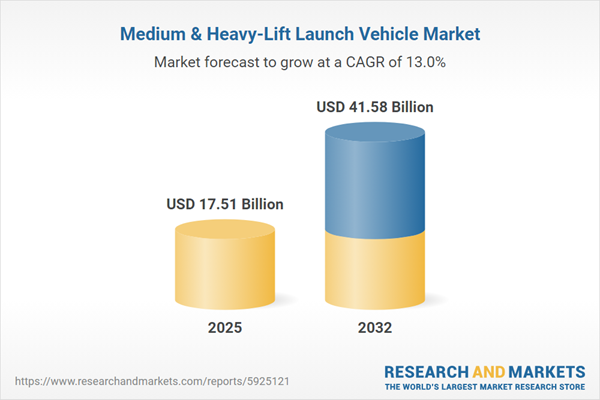Speak directly to the analyst to clarify any post sales queries you may have.
The medium and heavy-lift launch vehicle market is rapidly evolving as senior leaders across aerospace, defense, and commercial sectors refocus on technology innovation, reliable performance, and operational flexibility. Organizations are aligning launch capabilities to respond to intensifying geopolitical risks, greater interoperability requirements, and rising expectations for global access and service continuity.
Market Snapshot: Medium & Heavy-Lift Launch Vehicle Market Growth
In 2024, the medium and heavy-lift launch vehicle market is valued at USD 15.59 billion and projected to reach USD 17.51 billion in 2025, scaling to USD 41.58 billion by 2032 with a compound annual growth rate (CAGR) of 13.03%. This upward momentum reflects intensified investment from public and private organizations, positioning the medium and heavy-lift launch vehicle market as a core pillar of space infrastructure worldwide. Decision-makers must monitor shifting regulatory and technology standards that influence competition and shape operational decisions across international markets. As secure communications, connectivity, and mission integrity remain strategic imperatives, the sector’s competitive landscape continues to evolve.
Scope & Segmentation
- Payload Type: Cargo missions, crewed flights, satellite deployments, and exploratory spacecraft each require tailored integration and compliance strategies, ensuring effective mission alignment and robust risk management across wide-ranging launch scenarios.
- Payload Capacity: Launch vehicles are designed to accommodate objectives in defense, commercial, and research domains, providing versatile options for organizations seeking specific payload flexibility.
- Launch Platform: Utilization of ground-based, airborne, maritime, and submersible platforms extends operational reach and offers solutions adaptable to geographic, regulatory, and logistical constraints.
- Vehicle Type: Expendable and reusable launch vehicles give organizations flexibility to prioritize sustainability, cost efficiency, and rapid mission response in a dynamic marketplace.
- Vehicle Configuration: Single-payload and multi-payload launch vehicles support both independent and collaborative missions, maximizing scheduling options and asset use.
- Fuel Type: Solid and liquid propulsion systems influence operational protocols, safety compliance, and timely innovation across all segments.
- End-User: Primary stakeholders include defense agencies, telecommunications providers, research organizations, and government bodies leveraging launch vehicles for strategic advancement and commercial development.
- Ownership: The sector is shaped by evolving partnerships between commercial entities and public sector agencies, fostering investment, collaboration, and continuous innovation.
- Regional Scope: Activity spans North America, South America, Europe, Middle East & Africa, and Asia-Pacific, each region contributing unique regulatory perspectives and infrastructure strengths to global market dynamics.
- Key Companies: Market leaders such as SpaceX, Blue Origin Enterprises, Arianespace, United Launch Alliance, Northrop Grumman, Mitsubishi Heavy Industries, and ISRO drive advancements in performance benchmarking and technology integration worldwide.
Key Takeaways for Senior Decision-Makers
- Adoption of advanced materials and new propulsion solutions is optimizing mission planning and strengthening supply chain operational efficiency within the sector.
- Collaboration between established providers and emerging entrants is facilitating rapid technical know-how transfer while improving service deliverables for end-users.
- Flexible launch architectures, such as reusable and modular vehicle designs, enable scalable responses to diverse deployment needs, supporting evolving organizational mission priorities.
- Expanding participation through specialized service providers and ongoing regulatory updates is fostering a competitive environment that encourages innovation and improves market accessibility.
- Sustained investment in infrastructure and logistics capabilities is critical to enhancing stakeholder agility, improving responsiveness to customer and partner demands, and reducing operational delays.
Tariff Impact: Safeguarding Supply Chains and Market Access
Ongoing changes in trade and tariff regimes are prompting organizations to reinforce supplier networks and expand cross-border partnerships. By prioritizing robust risk management strategies and employing dual procurement practices, market participants maintain operational continuity and stable launch schedules while navigating regulatory and geopolitical shifts.
Medium & Heavy-Lift Launch Vehicle Market: Methodology & Data Sources
This market analysis draws on interviews with sector executives, targeted technical workshops, and highly specialized industry surveys to assess current and emerging trends. Supplemental scenario analysis, supply chain mapping, and regulatory assessments underpin insights that support strategic planning in this complex and evolving market segment.
Why This Report Matters
- Provides clear, actionable direction for executives seeking to understand key market drivers, enabling informed resource allocation and competitive positioning.
- Helps organizations align their operational plans to the latest regulatory, technological, and commercial trends, ensuring continued market relevance.
- Enables leaders to anticipate regulatory and technology shifts, enhancing resilience and compliance in a changing policy environment.
Conclusion
This research delivers pragmatic insight for senior decision-makers aiming to address emerging sector challenges, identify high-priority growth opportunities, and drive sustained performance amid rapid transformation in the launch vehicle industry.
Additional Product Information:
- Purchase of this report includes 1 year online access with quarterly updates.
- This report can be updated on request. Please contact our Customer Experience team using the Ask a Question widget on our website.
Table of Contents
3. Executive Summary
4. Market Overview
7. Cumulative Impact of Artificial Intelligence 2025
Companies Mentioned
The companies profiled in this Medium & Heavy-Lift Launch Vehicle market report include:- Blue Origin Enterprises, L.P.
- Arianespace SA by ArianeGroup
- Avio S.p.A. by GE Aerospace
- China Aerospace Science and Technology Corporation
- Ethereal Exploration Space and Defence Private Limited
- Firefly Aerospace Inc.
- IHI Aerospace Co., Ltd.
- Indian Space Research Organisation
- International Launch Services, Inc.
- Interorbital Systems
- Isar Aerospace Technologies GmbH
- Japan Aerospace Exploration Agency
- Korea Aerospace Research Institute
- Link Space Aerospace Technology Inc.
- Mitsubishi Heavy Industries, Ltd.
- Northrop Grumman Corporation
- Relativity Space, Inc.
- Rocket Lab USA, Inc.
- Space Exploration Technologies Corporation
- United Launch Alliance, LLC
Table Information
| Report Attribute | Details |
|---|---|
| No. of Pages | 180 |
| Published | November 2025 |
| Forecast Period | 2025 - 2032 |
| Estimated Market Value ( USD | $ 17.51 Billion |
| Forecasted Market Value ( USD | $ 41.58 Billion |
| Compound Annual Growth Rate | 13.0% |
| Regions Covered | Global |
| No. of Companies Mentioned | 21 |









